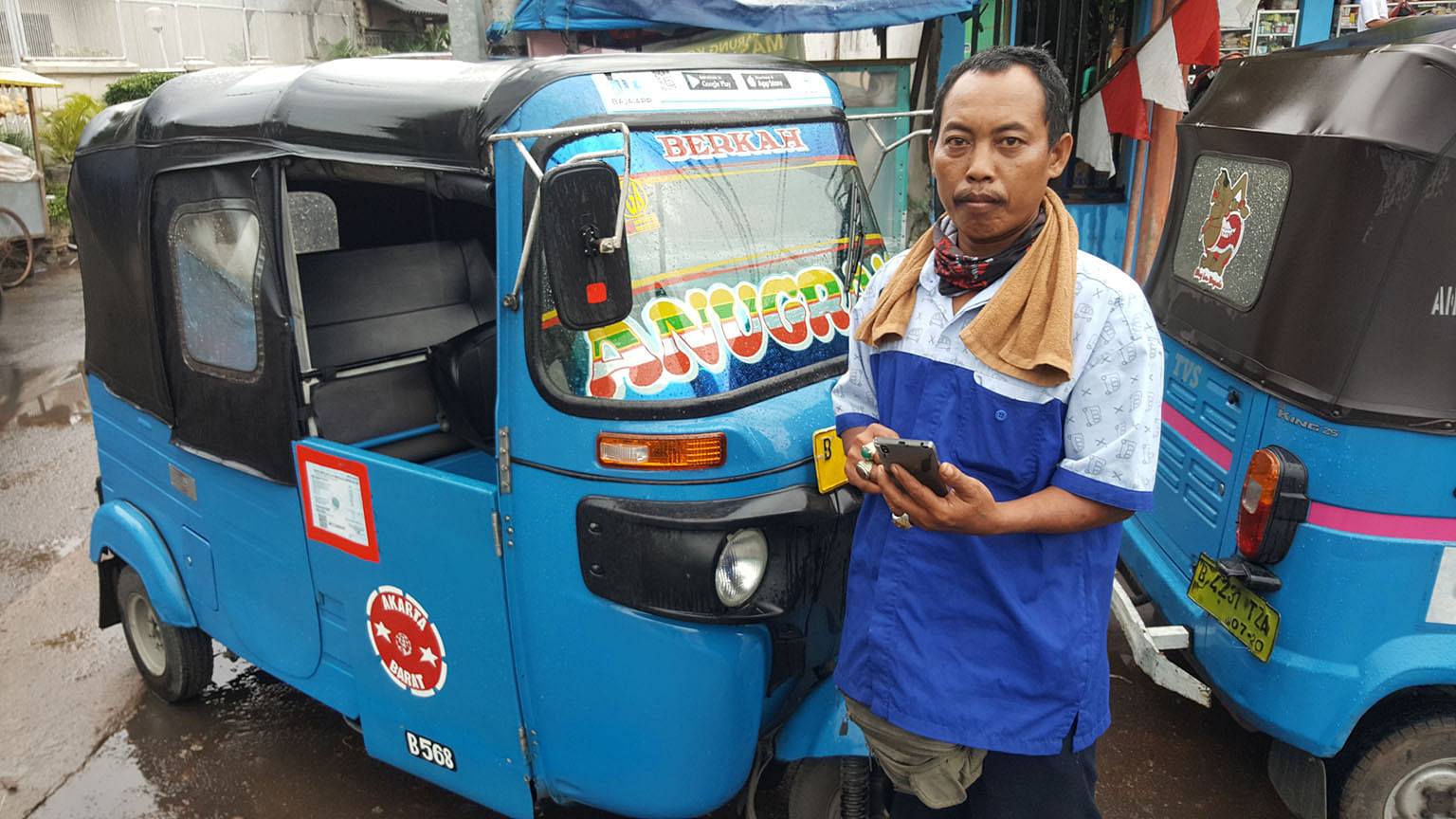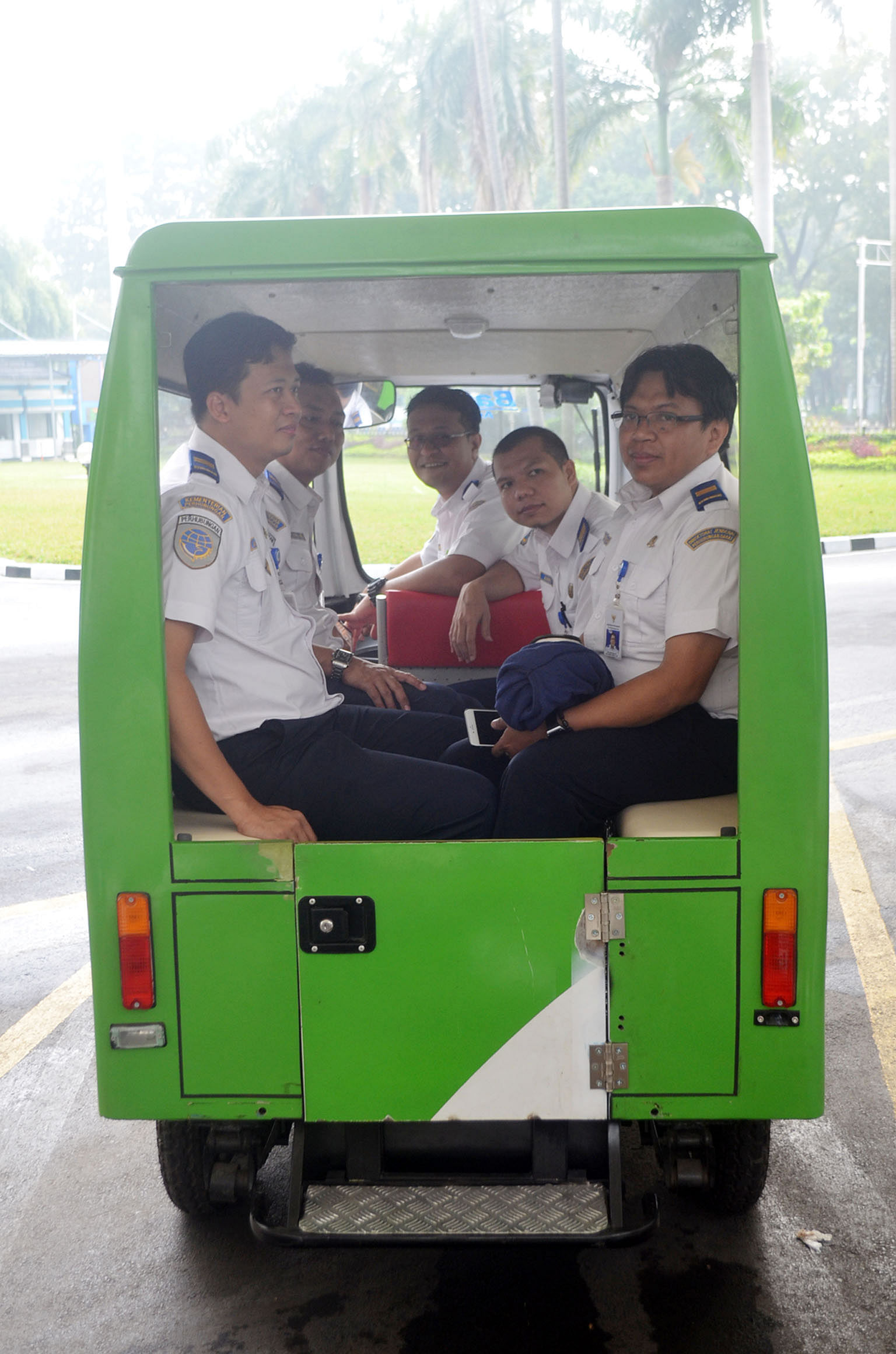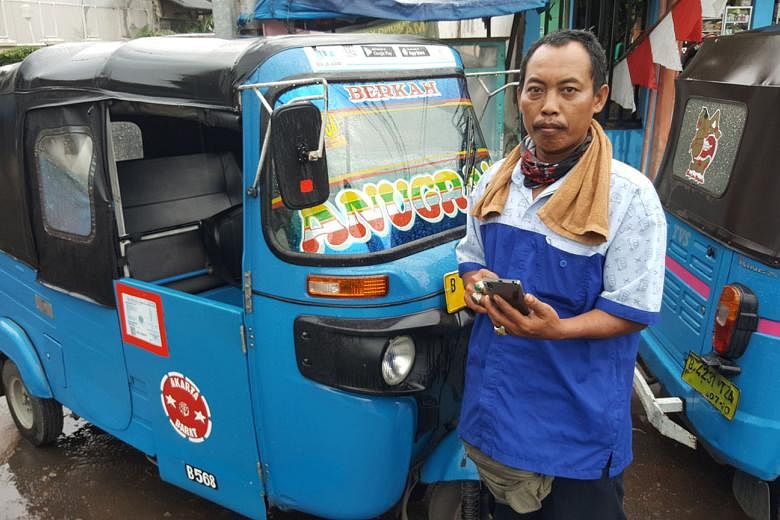JAKARTA • One afternoon earlier this month, the rain was pouring on central Jakarta. With her arms full of groceries, housewife Santi waited patiently outside a busy mall for an autorickshaw to take her home.
Before long, a blue three-wheeled vehicle zipped to a stop beside her after dodging the chaotic jumble of motorcycles and minivans crowding the narrow street.
The 43-year-old put her shopping bags in the back of the vehicle, climbed into the cab and drew close the plastic curtain.
Ten minutes later, she was home. The rickety ride on Jakarta's ubiquitous bajaj, as the vehicle is known in Indonesia, cost just 20,000 rupiah (S$2).
"Bajaj is the best," Ms Santi, who goes by one name, told The Straits Times.
"Taxis are more expensive, minivans don't take me to my doorstep and motorcycles are dangerous and don't shelter me from the sun and rain."
Forty years since its appearance on Jakarta's streets, the three-wheeled, fan-cooled, smoke-belching bajajs - pronounced ba-jai - have become a local icon and an indispensable part of everyday life in the Indonesian capital.

It has also become a symbol of resilience, having endured numerous efforts by the authorities to phase it out, as well as challenges posed by the rise of online ride-hailing services.

The latest restriction by the local government came only last week, when the Jakarta Transportation Agency (Dishub Jakarta) barred bajajs from waiting for passengers near the presidential palace.
"It's shameful (to be doing that) in front of the palace," agency official Harlem Simanjuntak told Kompas.com news website. "It's inappropriate and disorderly."
The love-hate relationship between bajajs and the Jakarta authorities dates back to 2003, when the latter tried to replace the cabs with the locally-made Kancil, a four-wheeled minicar which runs on gas.
The plan was scrapped after bajaj owners complained that the Kancils were too expensive.
Three years later, city officials called for the then all orange-coloured, petrol-powered bajajs to be replaced by newer, blue-coloured models fuelled by compressed natural gas.
That order, too, went unheeded.
The authorities have since capped bajaj numbers to the current 14,000 in operation and limited their operations to back lanes and byways. This time, the restriction has stuck.
"They treat us like the unwanted stepchild, calling us noisy, smoky, an eyesore and a road hazard. But we are poor people. How can we afford to pay the high rents for better vehicles?" bajaj driver Mulyadi, 55, said.
"Say what they like, we are here to stay," added Mr Mulyadi, who has been driving the autorickshaw for 20 years.
The service has become an industry in its own right. Dozens of cooperatives own the bajajs, with the seven biggest ones owning a few hundred bajajs each. The vehicle parts are made in India before being imported and assembled in Indonesia.
Acknowledging that it is impossible to stop bajajs from operating in the city of 10 million, Jakarta Governor Basuki Tjahaja Purnama, better known as Ahok, last year reiterated the call for conversion to more environmentally friendly vehicles. His target for the transition: by the end of this year.
To speed things up, the administration has weeded out monopolistic blue bajaj sellers, simplified the buying process and provided more mobile gas-refuelling units. So far, 90 per cent of the old bajajs have been replaced with the blue bajajs, according to data from the Organisation of Land Transport Owners, or Organda.
But the threats are far from over. App-based, ride-hailing services such as Go-jek and GrabBike have exploded in popularity recently and are putting a major dent in the pocket of bajaj drivers.
Drivers typically earn a few dollars a day, after paying S$12 on vehicle rent and S$4 for petrol. Few drivers can afford to buy bajajs, which cost around 80 million rupiah or S$8,000 each. With "online transportation" services eating into their earnings by as much as a third, they now take home a mere dollar or two.
Many bajaj drivers joined thousands of angry cabbies in March to protest against the ride-hailing app services. But as reality sinks in that a ban is unlikely, drivers now say they must shape up - or ship out.
BAJAJ GOES 'ONLINE'
The first time Mr Daryo Doyo, 49, responded to an online booking for a bajaj ride via his smartphone, his hands were shaking uncontrollably.
"I was so nervous and didn't want to make any mistake," he said.
The bajaj driver of 30 years said the motorcycle-hailing services had broken his rice bowl, forcing him to send his wife and three children back to their village in Tegal, in Central Java, to save on living expenses.
"Previously, I could earn S$5 to S$10 a day. But with the competition, sometimes I earned nothing. I couldn't even afford to pay the bajaj rent," he said.
He borrowed S$120 from his brother to buy a smartphone and registered himself on BajaiApp, an application that lets passengers hail bajajs with their smartphones that was launched last October.
Since then Mr Daryo said his income has doubled, to as much as S$20 a day.
BajaiApp takes bookings from passengers and calculates in advance the fare based on time taken and journey distance. Users can choose to pay by cash or credit for the trip, and even tip the drivers.
Mr Darwin Wijaya, one of BajaiApp's founders, said 3,000 drivers are registered so far. But three in 10 have dropped out. The majority of bajaj drivers are elderly and poorly educated. Many are also too poor to afford a smartphone.
"But our biggest difficulty is to change the mindsets of those who are resistant to change. They think it's too troublesome to learn, and prefer to stick to old habits," he said.
Which is why, said Mr Darwin, he has set up WhatsApp groups among drivers to clear any doubts they might have and keep them motivated.
"We have trained a 71-year-old who had never held a smartphone in his life," said Mr Darwin.
"He mistook the GPS tracker for the passenger. When he heard the GPS say 'turn right, turn left', he replied, 'Be patient please, ma'am.'
"But now, he's one of our top earners," he said.
Mr Syarifin, a 40-year-old who also uses the BajaiApp, said technology has made him more efficient.
"Passengers look for me, not the other way round. I just have to make sure I'm fast with my fingers," he said, laughing. "If we want to progress, we must not make excuses for ourselves."
Bajaj drivers say the entry of modern rivals has forced them to ditch their old lifestyles.
"I used to take long meal breaks and plenty of naps throughout the day, but not any more," said a driver called Suyono, who has been driving a bajaj for two decades. "If I don't actively hunt for passengers, others will grab them first."
But for some drivers like 54-year-old Dicky, old habits die hard. He said: "Is the phone now my boss? Must I respond each time it beeps? It's just too much change."
ELECTRIFYING THE FUTURE
On Indonesia's Independence Day on Aug 17, up to 50 white-and- green electric bajajs are expected to make their debut on the streets of Jakarta.
The brainchild of Mr Christoforus Richard, president director of local engineering company Arrtu Mega Energie, the bajajs are clean, green, and easily recharged using household electricity.
A full charge of five hours can power the bajaj for 150km, at an average speed of 60km per hour. The authorities have given him the green light to operate, Mr Christoforus said. He hopes to launch 100 units by year end, and up to 25,000 in future.
He plans to rent each bajaj for S$12 a day, and let the driver own it after two years. The driver will also be given five bajajs to operate, and an additional five after his fourth year.
"Bajajs now are all imported and expensive. The drivers work all day and go without sleep just to pay rent. How will their lives ever improve?" he told The Straits Times.
"With 10 bajajs, he can become his own boss," Mr Christoforus said.
Indeed, the bajaj seems to have many more miles to go as industry players explore ways to help it stay relevant.
Transport analyst Darmaningtyas, a director at the Institute for Transportation Studies, said bajajs have potential to expand to other parts of Indonesia which lack safe, tested modes of transport.
"In the future, they should all be running on meter, so there's no need to haggle over fares," he said.
That is precisely the plan of Mr Petrus Tukimin, Organda's board chairman for Jakarta.
He will introduce 18,000 blue bajajs in Gorontalo, in North Sulawesi province, next month.
He also plans to introduce the vehicle to Makassar, in South Sulawesi, and Yogyakarta and Semarang on Java island.
"We want bajajs to replace the rickshaws and pedicabs as they are more comfortable and safer for passengers," he said.
"Hopefully once we go national, the Indian bajaj manufacturer will want to invest in setting up a factory here," he added.
Mr Petrus said Organda and Dishub Jakarta also plan to introduce four-wheeled bajajs next year, as three-wheeled vehicles are not governed by the transportation law but just a ministerial directive.
Meanwhile, the Transportation Ministry is leaving the plans and regulations on bajajs in the hands of local governments.
"Bajajs are an integral part of Jakartans' lives," the ministry's multimodal transport director, Mr Cucu Mulyana, told The Straits Times.
"Until there's a comparable alternative transport that can ferry passengers point to point around their neighbourhoods, I don't think they will be eliminated just yet."



